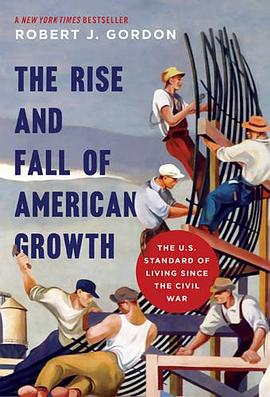The Rise and Fall of American Growth
内容简介
In the century after the Civil War, an economic revolution improved the American standard of living in ways previously unimaginable. Electric lighting, indoor plumbing, home appliances, motor vehicles, air travel, air conditioning, and television transformed households and workplaces. With medical advances, life expectancy between 1870 and 1970 grew from forty-five to seventy-two years. Weaving together a vivid narrative, historical anecdotes, and economic analysis, The Rise and Fall of American Growth provides an in-depth account of this momentous era. But has that era of unprecedented growth come to an end?
Gordon challenges the view that economic growth can or will continue unabated, and he demonstrates that the life-altering scale of innovations between 1870 and 1970 can't be repeated. He contends that the nation's productivity growth, which has already slowed to a crawl, will be further held back by the vexing headwinds of rising inequality, stagnating education, an aging population, and the rising debt of college students and the federal government. Gordon warns that the younger generation may be the first in American history that fails to exceed their parents' standard of living, and that rather than depend on the great advances of the past, we must find new solutions to overcome the challenges facing us.
A critical voice in the debates over economic stagnation, The Rise and Fall of American Growth is at once a tribute to a century of radical change and a harbinger of tougher times to come.
......(更多)
作者简介
Robert J. Gordon is the Stanley G. Harris Professor in the Social Sciences at Northwestern University. His books include Productivity Growth, Inflation, and Unemployment and Macroeconomics. Gordon was included in the 2013 Bloomberg list of the nation's most influential thinkers.
......(更多)
目录
Preface ix
1. Introduction: The Ascent and Descent of Growth 1
PART I. 1870-1940-THE GREAT INVENTIONS CREATE A REVOLUTION INSIDE AND OUTSIDE THE HOME 25
2. The Starting Point: Life and Work in 1870 27
3. What They Ate and Wore and Where They Bought It 62
4. The American Home: From Dark and Isolated to Bright and Networked 94
5. Motors Overtake Horses and Rail: Inventions and Incremental Improvements 129
6. From Telegraph to Talkies: Information, Communication, and Entertainment 172
7. Nasty, Brutish, and Short: Illness and Early Death 206
8. Working Conditions on the Job and at Home 247
9. Taking and Mitigating Risks: Consumer Credit, Insurance, and the Government 288
Entr'acte. The Midcentury Shift from Revolution to Evolution 319
PART II. 1940-2015-THE GOLDEN AGE AND THE EARLY WARNINGS OF SLOWER GROWTH 329
10. Fast Food, Synthetic Fibers, and Split-Level Subdivisions: The Slowing Transformation of Food, Clothing, and Housing 331
11. See the USA in Your Chevrolet or from a Plane Flying High Above 374
12. Entertainment and Communications from Milton Berle to the iPhone 409
13. Computers and the Internet from the Mainframe to Facebook 441
14. Antibiotics, CT Scans, and the Evolution of Health and Medicine 461
15. Work, Youth, and Retirement at Home and on the Job 498
Entr'acte. Toward an Understanding of Slower Growth 522
PART III. THE SOURCES OF FASTER AND SLOWER GROWTH 533
16. The Great Leap Forward from the 1920s to the 1950s: What Set of Miracles Created It? 535
17. Innovation: Can the Future Match the Great Inventions of the Past? 566
18. Inequality and the Other Headwinds: Long-Run American Economic Growth Slows to a Crawl 605
Postscript: America's Growth Achievement and the Path Ahead 641
Acknowledgments 653 Data Appendix 657 Notes 667
References 717 Credits 741 Index 745
......(更多)
读书文摘
尽管“二战”给美军带来了灾难性的伤亡(虽然与其他参战方更巨大的伤亡人数相比,美军伤亡人数已经少得多),但也造就了使美国经济摆脱30年代后期长期停滞的经济奇迹。
......(更多)






